For Red Bull athlete Tom Bridge, there really is no place like home. The banks and shorelines that prop up Exmouth in East Devon have helped the 19-year-old to become one of the world’s best freestyle kitesurfers, shaping everything from his skillset to his capacity for dealing with whatever the elements throw at him.
Of course it also helps that he comes from good stock, a sporting dynasty that keeps on giving. Mum, Steph, is a five-time kite race World Champion, who was ranked as the number one female in the world; Dad, Eric, has worked in the water sports industry for two decades, while his older brothers, Olly and Guy, are both fellow pros.
Watch Tom give a guided tour of his hometown in the player below, and meet the family members who’ve inspired, and helped shape, Tom’s kitesurfing career
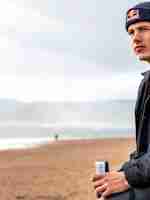
Now read on for a Q&A with Tom to find out more about why Exmouth is the perfect kitesurfing environment, how he pulls off such gravity-defying tricks and what some of his proudest moments have been in his career so far…
What makes Exmouth such a great place to kitesurf?
It’s so diverse. You can have flat water one day and wavy water the next, which makes you more of an all-round rider. There are two great spots in town – the estuary or the seafront – and a wide variety of conditions, too. There’s nowhere better anywhere.
Does this mix of the elements give you an edge in competition?

Tom Bridge competing in Red Bull King Of The Air in Cape Town in 2018
© Craig Kolesky/Red Bull Content Pool
That’s it – you’re more ready for whatever’s thrown at you. Most of the world’s so-called ‘best places to kitesurf’ are normally all flat water and that’s all you get. But if I had that every day then I’d just get bored. You want conditions that challenge you and push you. Exmouth gives you that.
You brought Exmouth to the world’s attention earlier this year with a session during Storm Ciara. How was that?
It was next level, everything was off the scale. We were only out on the water for half an hour and then we were just blown off it. You could barely hold onto the kite. You could see the wind was going over the water so quickly that it would pick up chops [waves that don’t break cleanly] and pass them over the water, it was crazy, something I’d never seen before.
How does your brain process that? What are the signs you use to spot danger?
You’re looking upwind a lot to see when the next gust is coming in, and you’re looking for different textures on the water to know where it’s really windy. In Exmouth, we live next to the sea so we’re looking at the ocean every single minute of every day, so we learn to read it well.
Most of the world’s so-called ‘best places to kitesurf’ are normally flat water. But if I had that every day then I’d just get bored
Tom Bridge, kitesurfer
What have your scariest moments been as a kitesurfer?
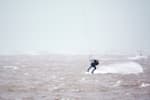
During Storm Ciara, Tom was blown off the water after just 30 minutes
© James Bannister / Red Bull Content Pool
I’ve had a couple of moments when I’ve misjudged it and landed on the beach at Exmouth, or been caught in the lines and pulled downwind for what seems like forever. The scariest experience I had actually came in Cape Town, aged 12, when I found myself pulled downwind toward these rocks and unable to stop it because I was in the line. My brother Olly had to come over and jump onto the kite, which really wrecked the kite but stopped it from pulling me to the rocks.
It must be great having your brothers in your corner…
For sure, it’s epic. I don’t know many other athletes who have family with them 24/7, who are as interested and as motivated to do the exact same thing as they are. When they’re out on the water not only do they have your back, they push you to do better things. When I started competing we would travel as a family to these UK junior events and it was such a good boost having them with me – it would often just be me and my brothers in one category, so we were all competing against each other. Together we’d go to these events and learn strategies and what to do in heats.
If it wasn’t for my mum and dad I wouldn’t be where I am now. They’ve been such a big factor for my career and have always told me just to be myself in the water and to stand out from the rest
Tom Bridge
What are your formative memories of kitesurfing with your parents?
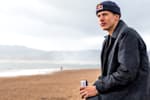
Tom distinctly remembers the family holiday that sparked his love of kiting
© Olaf Pignataro/Red Bull Content Pool
I remember being in the Caribbean on holiday, really young, and I couldn’t get my head around kitesurfing. Everyone else including my brothers were doing it but I wanted to do things I couldn’t do – I wanted to be pro before I could even do it. When I got back to Exmouth, I did it non-stop throughout the following year and it started to click. If it wasn’t for my mum and dad I wouldn’t be where I am now. They’ve been such a big factor for my career and have always told me just to be myself in the water and to stand out from the rest.
You’re now a world-class freestyler. Did you originally perform tricks to stand out or are you naturally good at them?
I always wanted to do what the pros were doing, so I always tried to do the hardest trick I could. Once I had the basics dialled in, and the fundamentals to land, spin and pass the bar behind my back, I could do any trick if I worked hard enough for it. Eventually I ended up ticking the hardest tricks off the list.
How long does it take you to work on a trick?
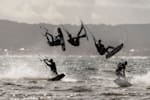
“Once you’ve done all the individual movements before, it’s muscle memory”
© Olaf Pignataro/Red Bull Content Pool
If I think of a trick at the start of a session, I can normally do them by the end. I barely think about them beforehand. Normally I’ll do something dumb on the water, it’ll work out and the trick will stem from there. Once you’ve done all the individual movements before, it’s muscle memory, it’s just putting it all together.
How about your favourite trick?
Probably my first Handle Pass when I was about nine, because that’s your gateway into professional tricks – passing the bar behind your back is what makes you. Although in 2017, aged 16, I’d gone over to Brazil, where I progressed so much and learned so many tricks. That’s where I did the Triple Half Cab. It was big. No one did it before me, and no one’s done it since. Whenever I do the trick I see stars afterwards – it sends me spinning, you’re pulling a lot of Gs. You start off doing a really hard edge upwind, getting tension in the line that sends you up into the air, then a half-axis 360, and as you come around from the 360, you put your legs over your head and do two backflips before landing back on the water. I think people loved it as they hadn’t seen it before.
Do you have a set list of tricks you know you can do for a competition?

Tom prefers to go with the flow rather than performing pre-planned tricks
© Olaf Pignataro/Red Bull Content Pool
Not really. I know stuff that scores well but I tend to freestyle it and do what feels right. Although if it’s all going to shit you should always aim to do something for the video highlight reel at the end. There’s no harm throwing in a nice trick like a Slim 7 – a triple rotation with one 360 going the opposite way. I’ve got them pretty dialled and it’s something I do pretty regularly.
What career achievements have meant the most to you?
Becoming a youth freestyle world champion was amazing. It feels a long time ago now. I’d never done anything like that before and my whole family were in Spain to see me win. But my favourite win was at Porto Pollo in Sardinia in the 2016 Men’s Freestyle Grand Slam, the first men’s contest I won. Straight after winning that I went home and bought a surfboard I’d had my eye on for a long time.
How do you use Red Bull in competition?
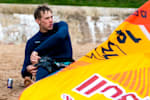
During competition Tom uses Red Bull to re-energise between heats
© Olaf Pignataro/Red Bull Content Pool
Before I go out for a training session and we’re all getting pretty pumped for it, I’ll crack one open. But during competition I’ll usually drink one between heats, maybe 15 minutes before that next one so I can get back to the rhythm, get that energy back. Then I’ll go and warm up and get used to the conditions again.
How did it feel being made a Red Bull athlete?
When I actually signed and had the helmet and hat in my house it felt surreal. I’d been working towards it for so long that, when it finally came, it felt really good. It’s a mental boost out on the water, too, especially when there are so few Red Bull athletes kiting.
How do you unwind in Exmouth when you’re not on the waves?
When I’m not on the water, either kitesurfing or regular surfing, I skate quite a lot. Exmouth’s a good town for that. When you’re younger you can go kiting in any wind, but when you’re bigger you can’t go out in lighter winds as much. So as I got older I started getting into other things like skating and BMXing. Although I stopped the BMX riding two years ago because I was getting hurt way too much.
Does the skateboarding have other benefits?
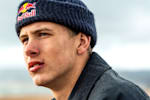
Tom finds that skateboarding helps him to unwind
© Olaf Pignataro / Red Bull Content Pool
Definitely. Any board sport helps with kiting. It also takes my mind away from things. When I’m kiting I feel like I have a certain level of expectation to live up to, especially with a Red Bull helmet on my head, but skating is purely for fun with mates. Skating also really helps with style, as the way you skate can influence the way you kite, helping to make stuff look better and finesse tricks better.
No one did the Triple Half Cab before me and nobody has done it since. Whenever I do the trick it sends me spinning, you’re pulling a lot of Gs
Tom Bridge, kitesurfer
What do you hope the next few years hold for you?
If some of the world tour events happen later this year, I definitely want to do them. Beyond that I want to put out a proper full-length video of the riding that I do and the styles, along with my brothers. That would be epic.




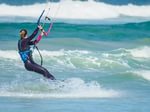
Recent Comments